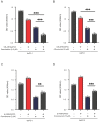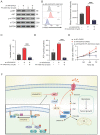ARHGAP25 Inhibits Pancreatic Adenocarcinoma Growth by Suppressing Glycolysis via AKT/mTOR Pathway
- PMID: 33994864
- PMCID: PMC8120455
- DOI: 10.7150/ijbs.55919
ARHGAP25 Inhibits Pancreatic Adenocarcinoma Growth by Suppressing Glycolysis via AKT/mTOR Pathway
Abstract
Increasing evidence reveals that the Rho GTPase-activating protein is a crucial negative regulator of Rho family GTPase involved in tumorigenesis. The Rho GTPase-activating protein 25 (ARHGAP25) has been shown to specifically inactivate the Rho family GTPase Rac1, which plays an important role in pancreatic adenocarcinoma (PAAD) progression. Therefore, here we aimed to clarify the expression and functional role of ARHGAP25 in PAAD. The ARHGAP25 expression was lower in PAAD tissues than that in normal pancreatic tissues based on bioinformatics analysis and immunohistochemistry staining. Overexpression of ARHGAP25 inhibited cell growth of AsPC-1 human pancreatic cancer cells in vitro, while opposite results were observed in BxPC-3 human pancreatic cancer cells with ARHGAP25 knockdown. Consistently, in vivo tumorigenicity assays also confirmed that ARHGAP25 overexpression suppressed tumor growth. Mechanically, overexpression of ARHGAP25 inactivated AKT/mTOR signaling pathway by regulating Rac1/PAK1 signaling, which was in line with the results from the Gene set enrichment analysis on The Cancer Genome Atlas dataset. Furthermore, we found that ARHGAP25 reduced HIF-1α-mediated glycolysis in PAAD cells. Treatment with PF-04691502, a dual PI3K/mTOR inhibitor, hampered the increased cell growth and glycolysis due to ARHGAP25 knockdown in PAAD cells. Altogether, these results conclude that ARHGAP25 acts as a tumor suppressor by inhibiting the AKT/mTOR signaling pathway, which might provide a therapeutic target for PAAD.
Keywords: AKT/mTOR signaling; ARHGAP25; glycolysis; pancreatic adenocarcinoma; proliferation..
© The author(s).
Conflict of interest statement
Competing Interests: The authors have declared that no competing interest exists.
Figures







Similar articles
-
CircRNA PGAM1 Promotes the Migration and Invasion of Pancreatic Adenocarcinoma Cells by Activating the AKT/mTOR Signaling Pathway.Mol Biotechnol. 2024 Sep;66(9):2341-2348. doi: 10.1007/s12033-023-00865-1. Epub 2023 Sep 13. Mol Biotechnol. 2024. PMID: 37702882
-
TRIM59 predicts poor prognosis and promotes pancreatic cancer progression via the PI3K/AKT/mTOR-glycolysis signaling axis.J Cell Biochem. 2020 Feb;121(2):1986-1997. doi: 10.1002/jcb.29433. Epub 2019 Nov 6. J Cell Biochem. 2020. PMID: 31693252
-
Functional inhibition of lactate dehydrogenase suppresses pancreatic adenocarcinoma progression.Clin Transl Med. 2021 Jun;11(6):e467. doi: 10.1002/ctm2.467. Clin Transl Med. 2021. PMID: 34185423 Free PMC article.
-
Harnessing impaired energy metabolism in cancer cell: small molecule- mediated ways to regulate tumorigenesis.Anticancer Agents Med Chem. 2011 Mar;11(3):272-9. doi: 10.2174/187152011795347531. Anticancer Agents Med Chem. 2011. PMID: 21434854 Review.
-
The role of AMPK in pancreatic cancer: from carcinogenesis to treatment.Clin Transl Oncol. 2025 Jan;27(1):70-82. doi: 10.1007/s12094-024-03572-8. Epub 2024 Jun 26. Clin Transl Oncol. 2025. PMID: 38926257 Review.
Cited by
-
Loss of RhoA in microglia disables glycolytic adaptation and impairs spinal cord injury recovery through Arhgap25/HIF-1α pathway.Cell Death Dis. 2025 Aug 22;16(1):636. doi: 10.1038/s41419-025-07947-9. Cell Death Dis. 2025. PMID: 40846818 Free PMC article.
-
Lacking ARHGAP25 mitigates the symptoms of autoantibody-induced arthritis in mice.Front Immunol. 2023 May 10;14:1182278. doi: 10.3389/fimmu.2023.1182278. eCollection 2023. Front Immunol. 2023. PMID: 37234175 Free PMC article.
-
Novel Inhibition of Central Carbon Metabolism Pathways by Rac and CDC42 inhibitor MBQ167 and Paclitaxel.Mol Cancer Ther. 2024 Nov 4;23(11):1613-1625. doi: 10.1158/1535-7163.MCT-23-0803. Mol Cancer Ther. 2024. PMID: 39087451 Free PMC article.
-
Fixing the GAP: The role of RhoGAPs in cancer.Eur J Cell Biol. 2022 Apr;101(2):151209. doi: 10.1016/j.ejcb.2022.151209. Epub 2022 Feb 10. Eur J Cell Biol. 2022. PMID: 35180567 Free PMC article. Review.
-
S100 calcium-binding protein A10 contributes to malignant traits in osteosarcoma cells by regulating glycolytic metabolism via the AKT/mTOR pathway.Bioengineered. 2022 May;13(5):12298-12308. doi: 10.1080/21655979.2022.2071022. Bioengineered. 2022. PMID: 35579448 Free PMC article.
References
-
- Bray F, Ferlay J, Soerjomataram I, Siegel RL, Torre LA, Jemal A. Global cancer statistics 2018: GLOBOCAN estimates of incidence and mortality worldwide for 36 cancers in 185 countries. CA Cancer J Clin. 2018;68:394–424. - PubMed
-
- Rahib L, Smith BD, Aizenberg R, Rosenzweig AB, Fleshman JM, Matrisian LM. Projecting cancer incidence and deaths to 2030: the unexpected burden of thyroid, liver, and pancreas cancers in the United States. Cancer Res. 2014;74:2913–21. - PubMed
-
- Siegel RL, Miller KD, Jemal A. Cancer statistics, 2020. CA Cancer J Clin. 2020;70:7–30. - PubMed
-
- Heasman SJ, Ridley AJ. Mammalian Rho GTPases: new insights into their functions from in vivo studies. Nat Rev Mol Cell Biol. 2008;9:690–701. - PubMed
Publication types
MeSH terms
Substances
LinkOut - more resources
Full Text Sources
Medical
Molecular Biology Databases
Research Materials
Miscellaneous

